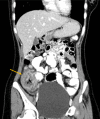Disseminated intestinal basidiobolomycosis with mycotic aneurysm mimicking obstructing colon cancer
- PMID: 30700449
- PMCID: PMC6352788
- DOI: 10.1136/bcr-2018-225054
Disseminated intestinal basidiobolomycosis with mycotic aneurysm mimicking obstructing colon cancer
Abstract
Basidiobolomycosis is a rare fungal infection that may affect the gastrointestinal tract. It is caused by Basidiobolus ranarum and less than 80 cases have been reported in the literature. The incidence seems to be higher in the Middle East and in particular Saudi Arabia where most cases are diagnosed in the south-western region. An 18-year-old woman presented to the emergency department with an obstructing caecal mass initially suspected to be malignant. Surgical resection was complicated by bowel perforation, histology and cultures confirmed basidiobolomycosis infection. The postoperative course was complicated by an enterocutaneous fistula, fungal intra-abdominal abscesses, liver and lung abscesses, formation of mycotic hepatic artery aneurysm and meningoencephalitis. The patient eventually expired due to sepsis despite aggressive treatment. Diagnosis and management of such rare cases are very challenging and require a multidisciplinary approach. Complications are common and associated with a high mortality.
Keywords: gastrointestinal surgery; gastrointestinal system; general surgery; infections; liver disease.
© BMJ Publishing Group Limited 2019. Re-use permitted under CC BY-NC. No commercial re-use. See rights and permissions. Published by BMJ.
Conflict of interest statement
Competing interests: None declared.
Figures








Similar articles
-
A fatal pseudo-tumour: disseminated basidiobolomycosis.BMC Infect Dis. 2006 Sep 15;6:140. doi: 10.1186/1471-2334-6-140. BMC Infect Dis. 2006. PMID: 16978407 Free PMC article.
-
Perforated appendicitis with gastrointestinal basidiobolomycosis: a rare finding.Surg Infect (Larchmt). 2014 Jun;15(3):339-42. doi: 10.1089/sur.2012.188. Epub 2013 Nov 4. Surg Infect (Larchmt). 2014. PMID: 24180345 Review.
-
Successful treatment of gastrointestinal basidiobolomycosis with voriconazole without surgical intervention.J Trop Pediatr. 2014 Dec;60(6):476-9. doi: 10.1093/tropej/fmu047. Epub 2014 Sep 10. J Trop Pediatr. 2014. PMID: 25213739
-
Diagnosis of gastrointestinal basidiobolomycosis: a mini-review.Mycoses. 2014 Dec;57 Suppl 3:138-43. doi: 10.1111/myc.12231. Epub 2014 Sep 3. Mycoses. 2014. PMID: 25186791 Review.
-
Unveiling the Uncommon: Gastrointestinal Basidiobolomycosis of the Colon and its Distinctive Splendore-Hoeppli Phenomenon.Int J Surg Pathol. 2025 Feb;33(1):112-116. doi: 10.1177/10668969241256116. Epub 2024 Jun 7. Int J Surg Pathol. 2025. PMID: 38847130
Cited by
-
Basidiobolomycosis Mimicking Fistulizing Crohn's Disease: A Case Report From Saudi Arabia.Cureus. 2023 Apr 22;15(4):e37981. doi: 10.7759/cureus.37981. eCollection 2023 Apr. Cureus. 2023. PMID: 37223202 Free PMC article.
-
Atypical presentation for a gastrointestinal basidiobolomycosis and rare side effect of Voriconazole: A case report and literature review.Med Mycol Case Rep. 2025 Jul 17;49:100719. doi: 10.1016/j.mmcr.2025.100719. eCollection 2025 Sep. Med Mycol Case Rep. 2025. PMID: 40727657 Free PMC article.
-
A Very Rare Basidiobolomycosis Case Presented with Cecal Perforation and Concomitant Hepatic Involvement in an Elderly Male Patient: A Case Study.Int J Environ Res Public Health. 2022 Mar 14;19(6):3412. doi: 10.3390/ijerph19063412. Int J Environ Res Public Health. 2022. PMID: 35329103 Free PMC article.
-
Gastrointestinal Basidiobolomycosis in a Child: Unusual Fungal Infection Mimicking Eosinophilic Gastrointestinal Diseases-A Case Report and Review of the Literature.JPGN Rep. 2021 Jul 22;2(3):e109. doi: 10.1097/PG9.0000000000000109. eCollection 2021 Aug. JPGN Rep. 2021. PMID: 37205942 Free PMC article.
-
Non-Candida mycosis in Gulf Cooperation Council (GCC) countries: perspective of a low-incidence region.BMC Infect Dis. 2025 Feb 23;25(1):253. doi: 10.1186/s12879-025-10680-5. BMC Infect Dis. 2025. PMID: 39988654 Free PMC article. Review.
References
Publication types
MeSH terms
LinkOut - more resources
Full Text Sources
Medical
